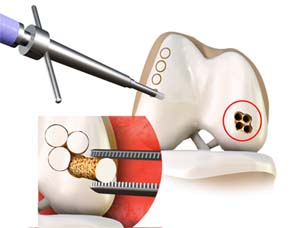Osteochondral Autograft Transfer System (OATS)

What is Articular Cartilage?
The articular surfaces of the body’s joints are lined by hyaline cartilage, a smooth tissue that serves as a shock absorber and allows easy movement of the bones within the joint. Normal wear-and-tear or injury can damage and cause defects in the cartilage, resulting in irregular articular surfaces that interfere with movement, causing pain, swelling and disability.
What is OATS?
Osteochondral autograft transfer system (OATS) is a type of cartilage transfer procedure.
Cartilage transfer procedures involve moving healthy cartilage from a non-weight-bearing area of the knee to a damaged area of the cartilage in the knee. There are two types.
- In mosaicplasty, plugs of cartilage and bone are taken from a healthy cartilage area and moved to replace the damaged cartilage of the knee. Multiple tiny plugs are used and once embedded, resemble a mosaic pattern; hence, the name.
- With the OATS procedure, the plugs are larger. Therefore, your surgeon only needs to move one or two plugs of healthy cartilage and bone to the damaged area of the knee.
Indications of OATS
OATS is not recommended in everyone. OATS is typically indicated if you are
- Aged <50
- Have minimal cartilage damage, usually because of trauma
- Have available healthy cartilage for transfer
OATS Procedure
In the OATS procedure, your surgery usually begins with an arthroscopic examination of your knee. Arthroscopy is performed in a hospital operating room under general anesthesia. Your surgeon makes a tiny incision over the knee and inserts an arthroscope. The arthroscope is a small fiber-optic viewing instrument made up of a tiny lens, light source and video camera that enables your surgeon to visually examine the knee.
The scope is removed and an incision is made over the knee. Using a special coring tool, your surgeon makes a hole in the cartilage sized to fit the plug exactly. Your surgeon then harvests the plug of healthy cartilage and bone from a non-weight-bearing region of the knee. This plug is transferred and implanted into the prepared hole of the damaged area of the knee. Over time, a successful OATS surgery will enable the bone and cartilage to grow into the damaged area of the knee, successfully resolving your knee pain.
Postoperative Recovery following OATS
Below are the steps for your postoperative recovery:
- You will wake up in the recovery room and transferred back to the ward.
- A bandage will be wound around the operated knee. You will usually be able to remove this the next day, but leave the Steri-Strips in place. These will fall off.
- Once you recover, your IV will be removed and you will be taught several exercises.
- Pain medication will be prescribed and should be taken as directed.
- It is normal for the knee to swell after the surgery. You will be sent home with a cryocuff cold therapy unit. Elevating your leg when you are seated and placing ice-packs or the cryocuff on your knee will help reduce the swelling (20 min 3-4 times a day until swelling has reduced).
- You will be sent home with a CPM machine (continuous passive motion) and given instructions on proper usage.
- You may shower once the bandage is removed. Leave the Steri-Strips intact.
- Please make an appointment 10-14 days after surgery to monitor your progress and remove your sutures.
- It is important to be compliant with your rehabilitation exercises to ensure a good outcome.
Risks and Complications of OATS
Risks related to the OATS surgery may include:
- Postoperative bleeding
- Deep vein thrombosis (DVT)
- Infection
- Stiffness
- Numbness of part of the skin near the incisions
- Injury to vessels, nerves, and chronic pain syndrome

